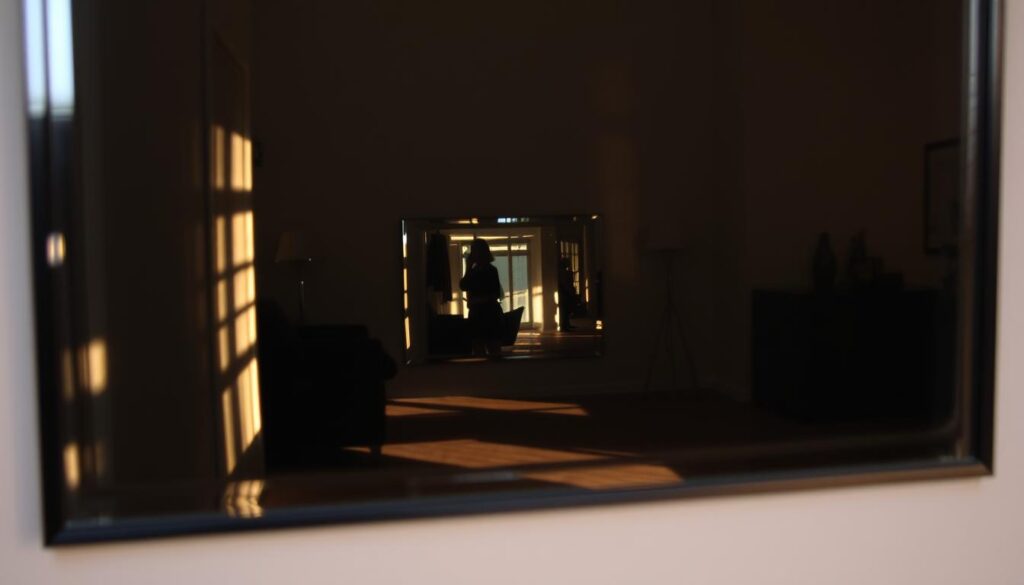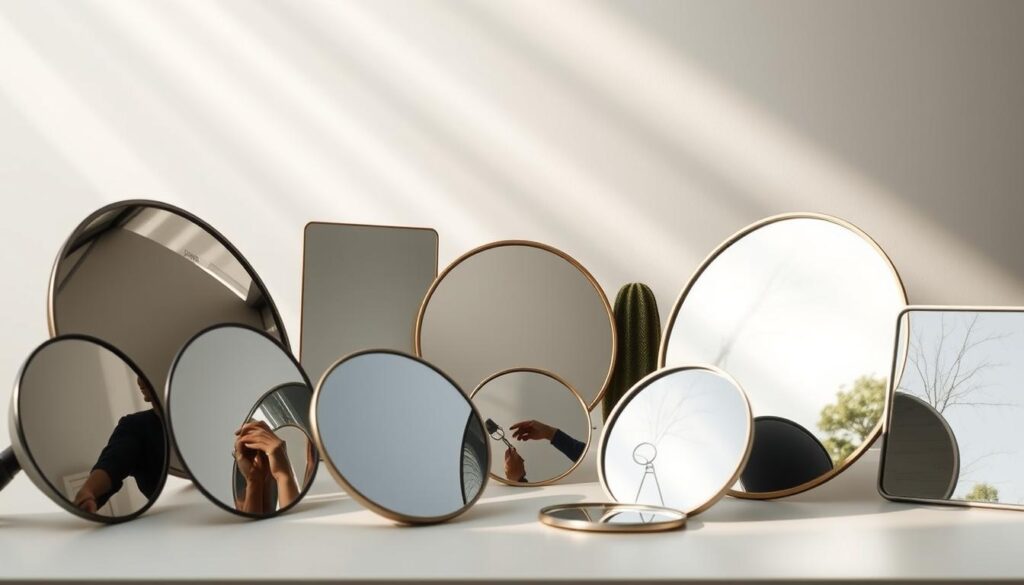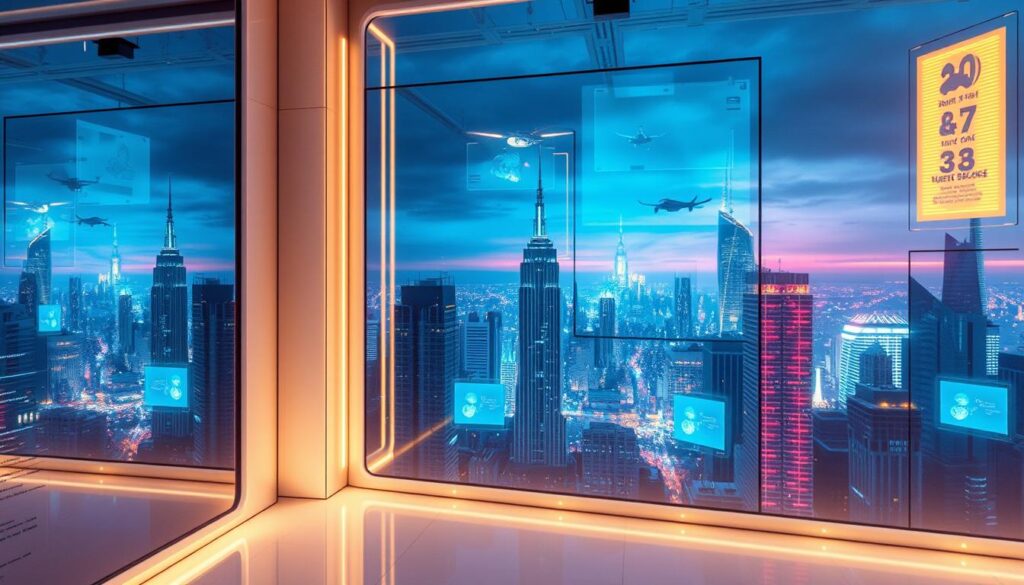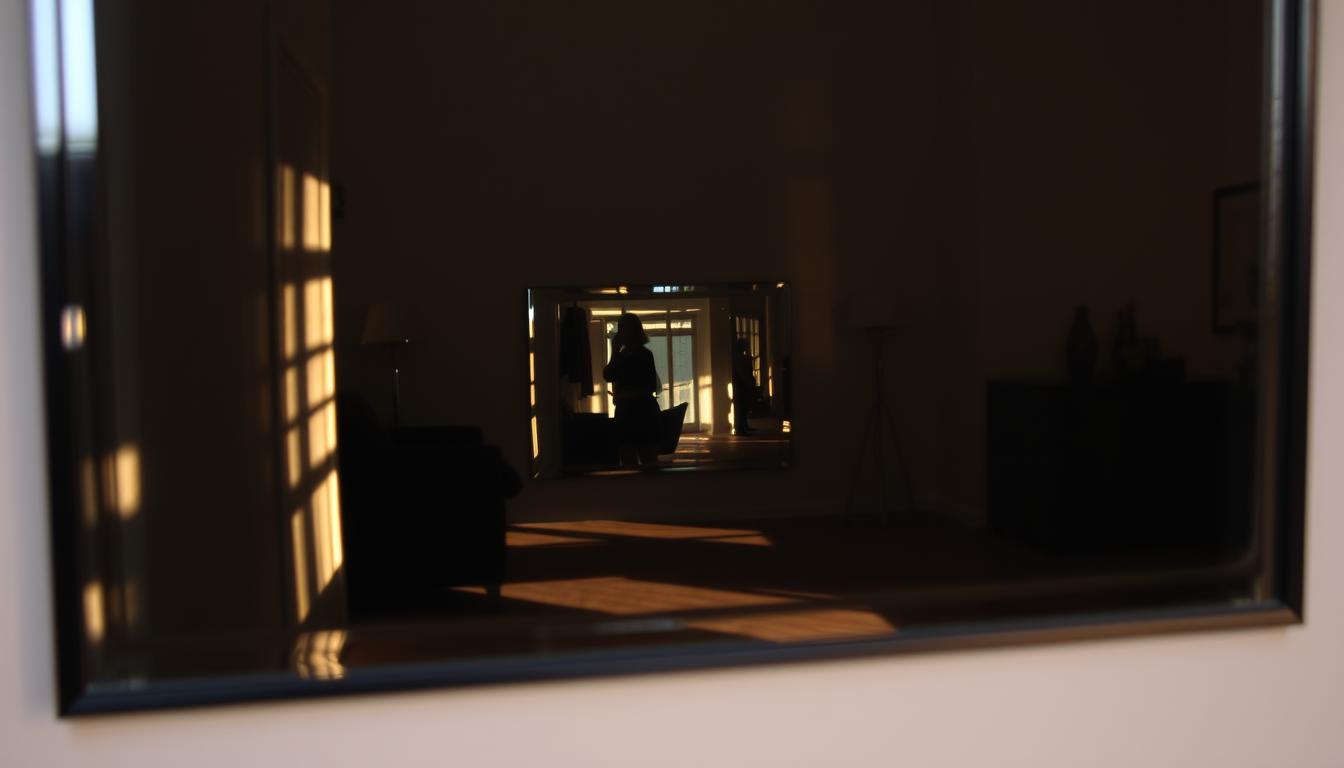When you look in a mirror, you usually see yourself clearly. But sometimes, mirror reflections can trick us, creating illusions. Mirrors have been around for centuries, captivating us with their reflections and optical tricks.

Mirrors show us more than just our looks. They reveal our inner selves too. By learning about mirrors and their science, we can understand ourselves better. This article will explore the fascinating world of mirror reflections and the secrets they hold.
Key Takeaways
- Mirrors can create mirror illusions that affect our mirror perception
- Mirror reflections are influenced by the way light interacts with the mirror surface
- Understanding the science behind mirror reflections can help us better understand ourselves
- Mirror perception is a complex phenomenon that involves both physical and psychological factors
- By exploring the world of mirror reflections, we can gain a deeper insight into the human experience
Understanding the Mystery Behind Mirror Reflections
When we look into a mirror, we see ourselves reflected back. But have you ever thought about how this happens? The magic of mirror reflections is rooted in light reflection and image formation.
The mirror reflection principles tell us that light hitting a surface bounces back. This is why we see our own image in the mirror.
The science behind mirror reflections is truly amazing. Light reflection is key to seeing ourselves in the mirror. When light from our body hits the mirror, it bounces back to our eyes. This creates the illusion of a mirrored image.
Here are some key points to understand about mirror reflections:
- Light reflection is the basis of mirror reflections
- Image formation occurs when light reflects off the mirror’s surface
- Mirror reflection principles govern how we see ourselves in the mirror
By grasping the basics of light reflection and image formation, we can better appreciate mirror reflections. The mirror reflection principles are crucial for creating the image we see. As we dive deeper into the science, we’ll see how these principles come together to create the mirrored illusion.
Why Your Mirror Reflects Something Different Than Expected
When you look into a mirror, you usually see yourself clearly. But sometimes, you might see unexpected reflections. This can happen for many reasons. The mirror’s quality, the room’s lighting, and how you look at yourself all play a part.
Light can cause mirror illusions. If the room is dim or the light is uneven, your reflection might look distorted. Also, a low-quality mirror can make your reflection look off too.
Here are some reasons why mirrors can show unexpected reflections:
- Lighting: The room’s light can change how you see yourself.
- Mirror quality: A better mirror shows a clearer reflection.
- Angle of view: How you look at yourself in the mirror matters too.
Knowing these factors helps us understand mirror reflections better. Sometimes, they can surprise us. Next, we’ll look into how our brains see these reflections.
The Physics of Mirror Perception
When we look into a mirror, we expect to see ourselves clearly. But, the physics behind mirror perception is more complex. Light waves are key in creating our reflection. The interaction of light with the mirror surface affects how clear our reflection is.
The angular reflection of light waves also plays a role. The angle at which light hits the mirror and returns to our eyes impacts our reflection’s clarity. Let’s explore the factors that influence mirror perception:
- Light wave frequency and amplitude
- Mirror surface quality and material
- Angular reflection patterns and viewing angle
Understanding mirror perception helps us appreciate light’s interaction with matter. Recognizing the physical factors that shape our reflection lets us grasp the science behind mirror illusions. This knowledge impacts our daily lives.
| Factor | Influence on Mirror Perception |
|---|---|
| Light wave frequency | Affects reflection clarity and accuracy |
| Angular reflection pattern | Influences viewing angle and reflection quality |
| Mirror surface quality | Affects reflection accuracy and clarity |
Common Mirror Illusions and Their Explanations
Looking into a mirror can surprise us with mirror illusions. These common illusions happen because of how our brains see things. They are explained by physics and psychology.
For example, mirrors can make us look bigger or smaller, or our body shape seems off. These tricks are due to the mirror’s shape, how we look at it, and the light around us. Knowing why these illusions happen helps us understand how our brains and reality connect.
Some common mirror illusions include:
- The “funhouse mirror” effect, where a curved mirror creates a distorted reflection
- The “vanishing point” illusion, where a mirror seems to create a never-ending corridor
- The “mirror box” illusion, where a mirror creates the illusion of a never-ending box
Learning about the science behind mirror illusions opens our eyes to the amazing world of optics and perception.
The Psychology Behind Mirror Perception
When we look into a mirror, we expect to see ourselves clearly. But, our mirror perception can be shaped by many psychological factors. Our self-image is a big influence on how we see ourselves in the mirror. It’s formed by our thoughts, feelings, and experiences, and can sometimes change how we see our reflection.
Our brains also have cognitive biases that can change how we see ourselves in the mirror. We might focus too much on our flaws and ignore our good qualities. This can make us see ourselves in a distorted way and hurt our self-esteem. Also, body dysmorphia is a condition where people get too caught up in their looks, often because of a wrong view of themselves in the mirror.
Here are some key points to consider about the psychology behind mirror perception:
- Our self-image plays a significant role in shaping our mirror perception
- Cognitive biases can distort our mirror reflection and affect our self-esteem
- Body dysmorphia is a condition that can arise from a distorted mirror perception
Understanding the psychological factors behind mirror perception can help us see ourselves more accurately and positively. It’s important to remember that our mirror reflection isn’t always true to reality. Our self-image and cognitive biases greatly influence how we perceive ourselves.
How Different Types of Mirrors Affect Your Reflection
When you look in a mirror, what you see can change a lot. The mirror’s quality, shape, and size all play a part. For example, a convex mirror makes you look smaller, while a concave mirror makes you look bigger.
The mirror’s type also affects how true your reflection is. A plane mirror shows a virtual image, but a curved mirror can distort it. Knowing about different mirrors helps you pick the best one for you.

Some common mirrors are: * Plane mirrors * Curved mirrors * Convex mirrors * Concave mirrors Each type changes your reflection in its own way. Choosing the right mirror can greatly affect how you see yourself.
In summary, the mirror you use changes your reflection a lot. By learning about different mirrors, you can choose the one that gives you the most accurate view of yourself.
The Role of Lighting in Mirror Reflections
Lighting is key in how we see ourselves in mirrors. The kind and strength of light can change how accurate our reflections look. Natural light is often the most flattering, giving a soft glow. But artificial light can sometimes make shadows and highlights look harsh.
To get the best reflection, think about where the light comes from. A light in the right spot can cut down on shadows and make the light more even. Here are some tips for the best lighting:
- Use a mix of natural and artificial light for a balanced look
- Place the light at an angle to avoid harsh shadows
- Change the light’s intensity to fit your needs
Understanding how lighting affects mirror reflections helps us improve our look. Whether it’s using natural light, adjusting artificial light, or trying different light setups, we can get a better reflection. This boosts our confidence and self-assurance every day.
| Lighting Type | Characteristics | Effect on Mirror Reflections |
|---|---|---|
| Natural Light | Soft, even illumination | Flattering, accurate reflections |
| Artificial Light | Harsh, uneven illumination | Unflattering, inaccurate reflections |
By thinking about how lighting affects our mirror reflections, we can control how we see ourselves. We can make changes to get a better reflection.
Digital Mirrors and Smart Technology
The world of digital mirrors and smart technology is changing fast. It brings new solutions to our everyday lives. Now, these devices do more than just show us our reflection. They give us personalized advice, track our health, and even control other smart devices at home.
Some of the benefits of digital mirrors include:
- Enhanced beauty and skincare routines with personalized product recommendations
- Improved health and wellness tracking, such as monitoring heart rate and blood pressure
- Increased convenience with voice control and smart home integration
As smart technology keeps getting better, digital mirrors will have even more cool features. They will become a key part of our daily lives. They offer a unique and personalized experience.

Cultural Perspectives on Mirror Reflections
Mirrors have always fascinated people worldwide. Each culture sees mirrors in its own special way. These views come from old stories, myths, and legends that have been shared for years. Learning about these views helps us understand mirrors’ role in different societies.
Throughout history, mirrors have been linked to magic and the spiritual. Historical beliefs about mirrors vary. Some believe mirrors show the truth, while others see them as tools for looking inward. How we see mirror reflections depends on our culture, with some cultures valuing their spiritual side more.
Many cultures think mirrors can uncover hidden truths and help us grow. Mirror reflections are also seen as symbols of vanity. Some believe looking too much in mirrors shows too much self-love. Looking into these views helps us see the many sides of mirror reflections.
Exploring Cultural Significance
- Different cultures have unique customs and rituals surrounding mirrors, such as covering mirrors during mourning periods or using mirrors in spiritual practices.
- Mirrors have been used as a tool for self-expression and artistic creativity, with many artists using mirrors as a medium for their work.
- Cultural perspectives on mirror reflections are influenced by historical beliefs, myths, and legends that have been passed down through generations.
By diving into these cultural views, we can better understand mirror reflections’ importance. This knowledge helps us value the variety and depth of human experiences and traditions around mirrors.
Practical Tips for Accurate Mirror Viewing
To see yourself clearly in a mirror, the mirror’s quality and the room’s lighting matter a lot. A top-notch mirror with a smooth surface will show you more accurately than a lower quality one. Also, the right lighting can greatly affect how you see your reflection.
Here are some practical tips for better mirror reflections:
- Use a mirror with a smooth, flat surface
- Position the mirror in a well-lit area, with minimal shadows
- Avoid using mirrors with distortions or imperfections
By following these tips, you can see yourself more accurately in mirrors. Remember, it’s not just about the mirror. The place where you use it also plays a big role.
Conclusion: Understanding Your True Reflection
As we wrap up our look at mirror reflections, it’s key to see how vital they are. Mirrors show us more than just our looks. They also reveal our self-image, biases, and emotional state.
We’ve learned a lot about seeing ourselves through mirrors. From light waves to mirror quality, each detail affects what we see. Understanding these can help us see ourselves more clearly.
Whether facing body issues, exploring mirror views across cultures, or aiming for a more honest self-view, the answer is complex. Seeing the real depth of our mirror reflections can offer insights and improve our self-image.
So, when you look in the mirror, remember it’s just part of the story. Use this moment to grow and discover yourself. Your reflection is more than an image; it’s a peek into your complex self.
FAQ
What are the basic principles of light reflection?
Light reflection happens when light hits a surface. It can be reflected, absorbed, or transmitted. The angle of incidence equals the angle of reflection. This makes the reflected light follow a predictable path.
How do mirrors actually work?
Mirrors reflect light. They have a reflective coating on the back of the glass. When light hits, it bounces off, creating an image behind the mirror.
Why do mirrors sometimes reflect something different than what we expect?
Mirrors reflect differently due to lighting, viewing angle, and mirror quality. Our brain’s processing also plays a role in unexpected reflections.
What is the role of light waves and mirror surfaces in mirror perception?
Light waves and mirror surfaces interact in mirror perception. Light is reflected at an angle equal to incidence. The mirror’s quality affects the reflection, sometimes causing distortions.
What are some common mirror illusions and their explanations?
Common illusions include the “mirror image” and “distorted reflection.” These are caused by how our brain processes mirror information and the mirror’s physical properties.
How does self-image and cognitive biases affect mirror perception?
Our self-image and biases influence how we see ourselves in mirrors. Factors like body dysmorphia and self-esteem can distort our perception.
How do different types of mirrors affect your reflection?
Mirrors like concave and convex ones change how we see ourselves. Concave mirrors make objects appear smaller, while convex ones make them appear larger. The mirror’s shape can also distort reflections.
How does lighting affect mirror reflections?
Lighting greatly impacts mirror reflections. Natural and artificial light can create shadows and highlights. This alters the reflection’s appearance.
What are the latest advancements in digital mirrors and smart technology?
Digital mirrors now have features like lighting controls and augmented reality. They offer a more interactive experience but raise privacy concerns.
What are some cultural perspectives on mirror reflections?
Mirrors have cultural significance. Some believe they have spiritual properties, while others see them as tools for self-reflection. Understanding these views can give insights into mirror perception.
What are some practical tips for accurate mirror viewing?
For accurate viewing, consider lighting, mirror quality, and angle. Proper lighting and a high-quality mirror ensure a true reflection. Positioning the mirror correctly also helps.
